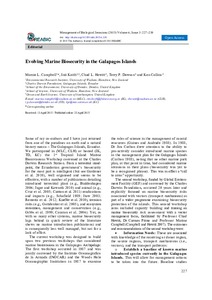| dc.contributor.author | Campbell, Marnie L. | |
| dc.contributor.author | Inti, Keith | |
| dc.contributor.author | Hewitt, Chad L. | |
| dc.contributor.author | Dawson, Terry P. | |
| dc.contributor.author | Collins, Ken | |
| dc.coverage.spatial | Galapagos Islands | |
| dc.coverage.spatial | Tropica East Pacific Ocean | |
| dc.date.accessioned | 2019-08-05T20:02:25Z | |
| dc.date.available | 2019-08-05T20:02:25Z | |
| dc.date.issued | 2015 | |
| dc.identifier.citation | Campbell, M.L.; Keith, I.; Hewitt, C.H.; Dawson, T.P. and Collins, K. (2015) Evolving Marine Biosecurity in the Galapagos Islands. Management of Biological Invasions, 6, pp.227–230. DOI: http://dx.doi.org/10.3391/mbi.2015.6.3.01 | en_US |
| dc.identifier.uri | http://hdl.handle.net/11329/1003 | |
| dc.identifier.uri | http://dx.doi.org/10.25607/OBP-535 | |
| dc.description.abstract | Some of my co-authors and I have just returned
from one of the paradises on earth and a natural
history mecca – The Galapagos Islands, Ecuador.
We participated in (MLC, CLH) or hosted (IK,
TD, KC) the 1st Tropical Island Marine
Bioinvasions Workshop convened at the Charles
Darwin Research Station. From a terrestrial standpoint, the Ecuadorian government’s biosecurity
for the most part is intelligent (but see Gardener
et al. 2010), well organised and seems to be
effective, with a number of publications detailing
introduced terrestrial plant (e.g., Buddenhagen
2006; Jager and Kowarik 2010) and animal (e.g.,
Cruz et al. 2005; Carrion et al. 2011) eradications
and impacts (e.g., Schofield 1989; Itow 2003;
Renteria et al. 2012; Kueffer et al. 2010), invasion
risks (e.g., Gottdenker et al. 2005), and ecosystem
restoration, management and conservation (e.g.,
Gibbs et al. 1999; Causton et al. 2006). Yet, as
with so many other systems, marine biosecurity
lags behind (a quick review of the literature
shows no marine introduction publications) and
is consequently less well managed, but not for a
lack of effort. | en_US |
| dc.language.iso | en | en_US |
| dc.rights | Attribution 4.0 International | * |
| dc.rights.uri | http://creativecommons.org/licenses/by/4.0/ | * |
| dc.subject.other | Invasive species | en_US |
| dc.subject.other | Marine biosecurity | en_US |
| dc.title | Evolving Marine Biosecurity in the Galapagos Islands. | en_US |
| dc.type | Journal Contribution | en_US |
| dc.description.refereed | Refereed | en_US |
| dc.format.pagerange | pp.227-230 | en_US |
| dc.identifier.doi | http://dx.doi.org/10.3391/mbi.2015.6.3.01 | |
| dc.subject.parameterDiscipline | Parameter Discipline::Biological oceanography::Biota composition | en_US |
| dc.bibliographicCitation.title | Management of Biological Invasions | en_US |
| dc.bibliographicCitation.volume | 6 | en_US |
| dc.description.sdg | 14 | en_US |
| dc.description.maturitylevel | Mature: Methodologies are well demonstrated for a given objective, documented and peer reviewed; methods are commonly used by more than one organization (TRL 7-9) | en_US |
| dc.description.bptype | Guide | en_US |
| obps.contact.contactname | Marnie Campbell | |
| obps.contact.contactemail | marnie.campbell@waikato.ac.nz | |
| obps.resourceurl.publisher | https://www.reabic.net/journals/mbi/2015/3/MBI_2015_Campbell_etal.pdf | en_US |
 Repository of community practices in Ocean Research, Applications and Data/Information Management
Repository of community practices in Ocean Research, Applications and Data/Information Management

